Sung-Hoon Yoon
Language-Agnostic Suicidal Risk Detection Using Large Language Models
May 26, 2025Abstract:Suicidal risk detection in adolescents is a critical challenge, yet existing methods rely on language-specific models, limiting scalability and generalization. This study introduces a novel language-agnostic framework for suicidal risk assessment with large language models (LLMs). We generate Chinese transcripts from speech using an ASR model and then employ LLMs with prompt-based queries to extract suicidal risk-related features from these transcripts. The extracted features are retained in both Chinese and English to enable cross-linguistic analysis and then used to fine-tune corresponding pretrained language models independently. Experimental results show that our method achieves performance comparable to direct fine-tuning with ASR results or to models trained solely on Chinese suicidal risk-related features, demonstrating its potential to overcome language constraints and improve the robustness of suicidal risk assessment.
Domain Adversarial Training for Mitigating Gender Bias in Speech-based Mental Health Detection
May 06, 2025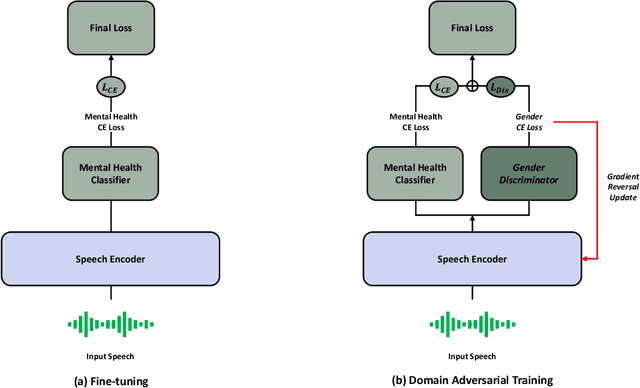



Abstract:Speech-based AI models are emerging as powerful tools for detecting depression and the presence of Post-traumatic stress disorder (PTSD), offering a non-invasive and cost-effective way to assess mental health. However, these models often struggle with gender bias, which can lead to unfair and inaccurate predictions. In this study, our study addresses this issue by introducing a domain adversarial training approach that explicitly considers gender differences in speech-based depression and PTSD detection. Specifically, we treat different genders as distinct domains and integrate this information into a pretrained speech foundation model. We then validate its effectiveness on the E-DAIC dataset to assess its impact on performance. Experimental results show that our method notably improves detection performance, increasing the F1-score by up to 13.29 percentage points compared to the baseline. This highlights the importance of addressing demographic disparities in AI-driven mental health assessment.
Finding Meaning in Points: Weakly Supervised Semantic Segmentation for Event Cameras
Jul 15, 2024

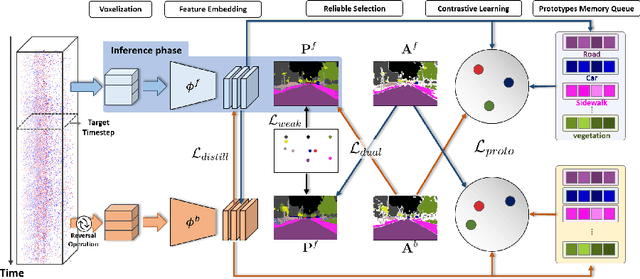

Abstract:Event cameras excel in capturing high-contrast scenes and dynamic objects, offering a significant advantage over traditional frame-based cameras. Despite active research into leveraging event cameras for semantic segmentation, generating pixel-wise dense semantic maps for such challenging scenarios remains labor-intensive. As a remedy, we present EV-WSSS: a novel weakly supervised approach for event-based semantic segmentation that utilizes sparse point annotations. To fully leverage the temporal characteristics of event data, the proposed framework performs asymmetric dual-student learning between 1) the original forward event data and 2) the longer reversed event data, which contain complementary information from the past and the future, respectively. Besides, to mitigate the challenges posed by sparse supervision, we propose feature-level contrastive learning based on class-wise prototypes, carefully aggregated at both spatial region and sample levels. Additionally, we further excavate the potential of our dual-student learning model by exchanging prototypes between the two learning paths, thereby harnessing their complementary strengths. With extensive experiments on various datasets, including DSEC Night-Point with sparse point annotations newly provided by this paper, the proposed method achieves substantial segmentation results even without relying on pixel-level dense ground truths. The code and dataset are available at https://github.com/Chohoonhee/EV-WSSS.
T4P: Test-Time Training of Trajectory Prediction via Masked Autoencoder and Actor-specific Token Memory
Mar 15, 2024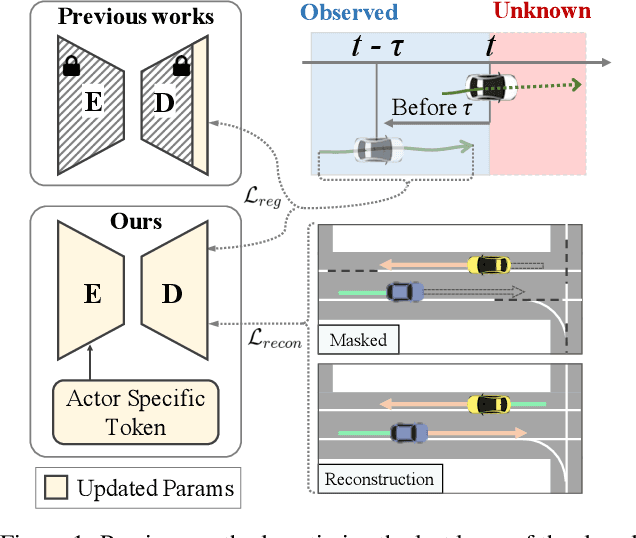
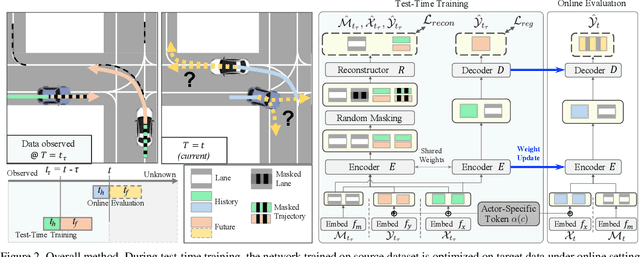
Abstract:Trajectory prediction is a challenging problem that requires considering interactions among multiple actors and the surrounding environment. While data-driven approaches have been used to address this complex problem, they suffer from unreliable predictions under distribution shifts during test time. Accordingly, several online learning methods have been proposed using regression loss from the ground truth of observed data leveraging the auto-labeling nature of trajectory prediction task. We mainly tackle the following two issues. First, previous works underfit and overfit as they only optimize the last layer of the motion decoder. To this end, we employ the masked autoencoder (MAE) for representation learning to encourage complex interaction modeling in shifted test distribution for updating deeper layers. Second, utilizing the sequential nature of driving data, we propose an actor-specific token memory that enables the test-time learning of actor-wise motion characteristics. Our proposed method has been validated across various challenging cross-dataset distribution shift scenarios including nuScenes, Lyft, Waymo, and Interaction. Our method surpasses the performance of existing state-of-the-art online learning methods in terms of both prediction accuracy and computational efficiency. The code is available at https://github.com/daeheepark/T4P.
Exploring Pixel-level Self-supervision for Weakly Supervised Semantic Segmentation
Dec 10, 2021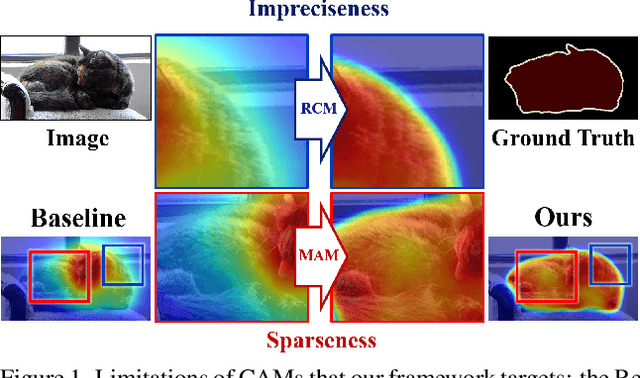
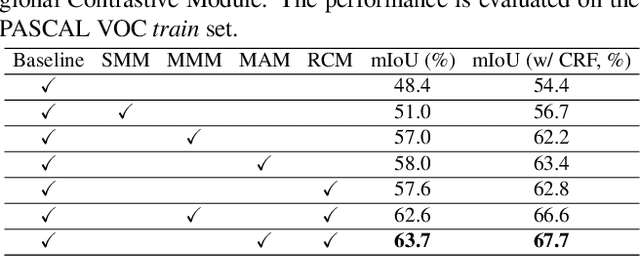
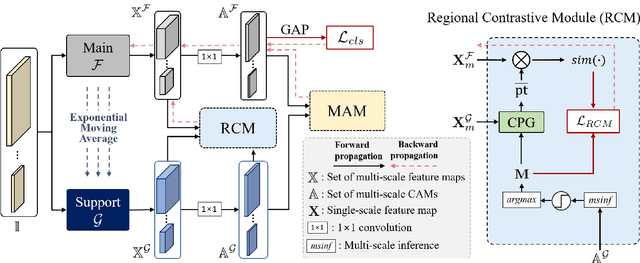
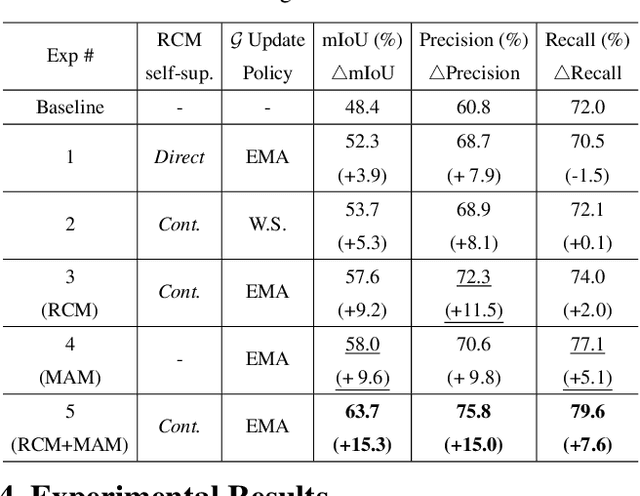
Abstract:Existing studies in weakly supervised semantic segmentation (WSSS) have utilized class activation maps (CAMs) to localize the class objects. However, since a classification loss is insufficient for providing precise object regions, CAMs tend to be biased towards discriminative patterns (i.e., sparseness) and do not provide precise object boundary information (i.e., impreciseness). To resolve these limitations, we propose a novel framework (composed of MainNet and SupportNet.) that derives pixel-level self-supervision from given image-level supervision. In our framework, with the help of the proposed Regional Contrastive Module (RCM) and Multi-scale Attentive Module (MAM), MainNet is trained by self-supervision from the SupportNet. The RCM extracts two forms of self-supervision from SupportNet: (1) class region masks generated from the CAMs and (2) class-wise prototypes obtained from the features according to the class region masks. Then, every pixel-wise feature of the MainNet is trained by the prototype in a contrastive manner, sharpening the resulting CAMs. The MAM utilizes CAMs inferred at multiple scales from the SupportNet as self-supervision to guide the MainNet. Based on the dissimilarity between the multi-scale CAMs from MainNet and SupportNet, CAMs from the MainNet are trained to expand to the less-discriminative regions. The proposed method shows state-of-the-art WSSS performance both on the train and validation sets on the PASCAL VOC 2012 dataset. For reproducibility, code will be available publicly soon.
EvDistill: Asynchronous Events to End-task Learning via Bidirectional Reconstruction-guided Cross-modal Knowledge Distillation
Nov 24, 2021



Abstract:Event cameras sense per-pixel intensity changes and produce asynchronous event streams with high dynamic range and less motion blur, showing advantages over conventional cameras. A hurdle of training event-based models is the lack of large qualitative labeled data. Prior works learning end-tasks mostly rely on labeled or pseudo-labeled datasets obtained from the active pixel sensor (APS) frames; however, such datasets' quality is far from rivaling those based on the canonical images. In this paper, we propose a novel approach, called \textbf{EvDistill}, to learn a student network on the unlabeled and unpaired event data (target modality) via knowledge distillation (KD) from a teacher network trained with large-scale, labeled image data (source modality). To enable KD across the unpaired modalities, we first propose a bidirectional modality reconstruction (BMR) module to bridge both modalities and simultaneously exploit them to distill knowledge via the crafted pairs, causing no extra computation in the inference. The BMR is improved by the end-tasks and KD losses in an end-to-end manner. Second, we leverage the structural similarities of both modalities and adapt the knowledge by matching their distributions. Moreover, as most prior feature KD methods are uni-modality and less applicable to our problem, we propose to leverage an affinity graph KD loss to boost the distillation. Our extensive experiments on semantic segmentation and object recognition demonstrate that EvDistill achieves significantly better results than the prior works and KD with only events and APS frames.
 Add to Chrome
Add to Chrome Add to Firefox
Add to Firefox Add to Edge
Add to Edge